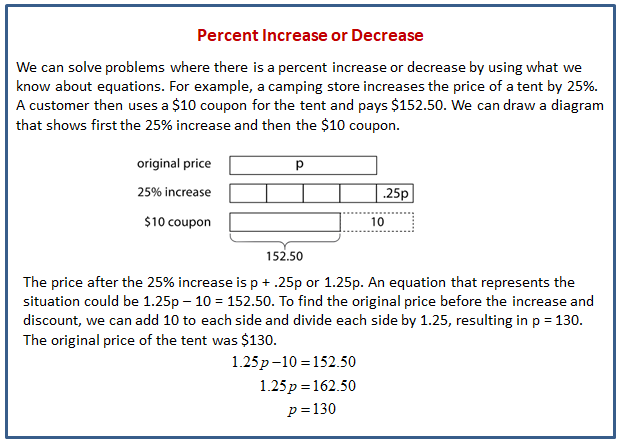Illustrative Mathematics Grade 7, Unit 6, Lesson 12: Solving Problems about Percent Increase or Decrease
Learning Targets:
- I can solve story problems about percent increase or decrease by drawing and reasoning about a tape diagram or by writing and solving an equation.
Related Pages
Illustrative Math
Grade 7
Lesson 12: Solving Problems about Percent Increase or Decrease
Let’s use tape diagrams, equations, and reasoning to solve problems with negatives and percents.
Illustrative Math Unit 7.6, Lesson 12 (printable worksheets)
Lesson 12 Summary
The following diagram shows how to use tape diagrams, equations, and reasoning to solve problems with negatives and percents.

Lesson 12.1 20% Off
An item costs x dollars and then a 20% discount is applied. Select all the expressions that could represent the price of the item after the discount.
- 20/100 x
- x - 20/100 x
- (1 - 0.20)x
- (100 - 20)/100 x
- 0.80x
- (100 - 20)x
Lesson 12.2 Walking More Each Day
- Mai started a new exercise program. On the second day, she walked 5 minutes more than on the first day. On the third day, she increased her walking time from day 2 by 20% and walked for 42 minutes. Mai drew a diagram to show her progress. Explain how the diagram represents the situation.
- Noah said the equation 1.20(d + 5) = 42 also represents the situation. Do you agree with Noah? Explain your reasoning.
- Find the number of minutes Mai walked on the first day. Did you use the diagram, the equation, or another strategy? Explain or show your reasoning.
- Mai has been walking indoors because of cold temperatures. On Day 4 at noon, Mai hears a report that the temperature is only 9 degrees Fahrenheit. She remembers the morning news reporting that the temperature had doubled since midnight and was expected to rise 15 degrees by noon. Mai is pretty sure she can draw a diagram to represent this situation but isn’t sure if the equation is 9 = 15 + 2t or 2(t + 15) = 9. What would you tell Mai about the diagram and the equation and how they might be useful to find the temperature, t, at midnight?
Lesson 12.3 A Sale on Shoes
- A store is having a sale where all shoes are discounted by 20%. Diego has a coupon for $3 off of the regular price for one pair of shoes. The store first applies the coupon and then takes 20% off of the reduced price. If Diego pays $18.40 for a pair of shoes, what was their original price before the sale and without the coupon?
- Before the sale, the store had 100 pairs of flip flops in stock. After selling some, they notice that 3/5 of the flip flops they have left are blue. If the store has 39 pairs of blue flip flops, how many pairs of flip flops (any color) have they sold?
- When the store had sold 2/9 of the boots that were on display, they brought out another 34 pairs from the stock room. If that gave them 174 pairs of boots out, how many pairs were on display originally?
- On the morning of the sale, the store donated 50 pairs of shoes to a homeless shelter. Then they sold 64% of their remaining inventory during the sale. If the store had 288 pairs after the donation and the sale, how many pairs of shoes did they have at the start?
Are you ready for more?
A coffee shop offers a special: 33% extra free or 33% off the regular price. Which offer is a better deal? Explain your reasoning.
-
Show Answer
33% off the regular price is a better deal.
If we consider that the regular price is $1 per cup.
33% extra would mean $1 for 1.33 cups, which would be 100/1.33 = 75 cents per cup
33% off the regular price 100 - 33 = 67 cents per cup.
Lesson 12 Practice Problems
- A backpack normally costs $25 but it is on sale for $21. What percentage is the discount?
- Find each product.
a. 2/5 · (-10)
b. -8 · (-3/2)
c. 10/6 · 0.6
d. (-100/37) · (-0.37) - Select all expressions that show x increased by 35%.
- Complete each sentence with the word discount, deposit, or withdrawal.
a. Clare took $20 out of her bank account. She made a _____.
b. Kiran used a coupon when he bought a pair of shoes. He got a _____.
c. Priya put $20 into her bank account. She made a _____.
d. Lin paid less than usual for a pack of gum because it was on sale. She got a _____. - Here are two stories:
- The initial freshman class at a college is 10% smaller than last year’s class. But then during the first week of classes, 20 more students enroll. There are then 830 students in the freshman class.
- A store reduces the price of a computer by $20. Then during a 10% off sale, a customer pays $830.
Here are two equations: - 0.9x + 20 = 830
- 0.9(x - 20) = 830
a. Decide which equation represents each story.
b. Explain why one equation has parentheses and the other doesn’t.
c. Solve each equation, and explain what the solution means in the situation.
The Open Up Resources math curriculum is free to download from the Open Up Resources website and is also available from Illustrative Mathematics.
Try out our new and fun Fraction Concoction Game.
Add and subtract fractions to make exciting fraction concoctions following a recipe. There are four levels of difficulty: Easy, medium, hard and insane. Practice the basics of fraction addition and subtraction or challenge yourself with the insane level.

We welcome your feedback, comments and questions about this site or page. Please submit your feedback or enquiries via our Feedback page.